Page 12 of 558
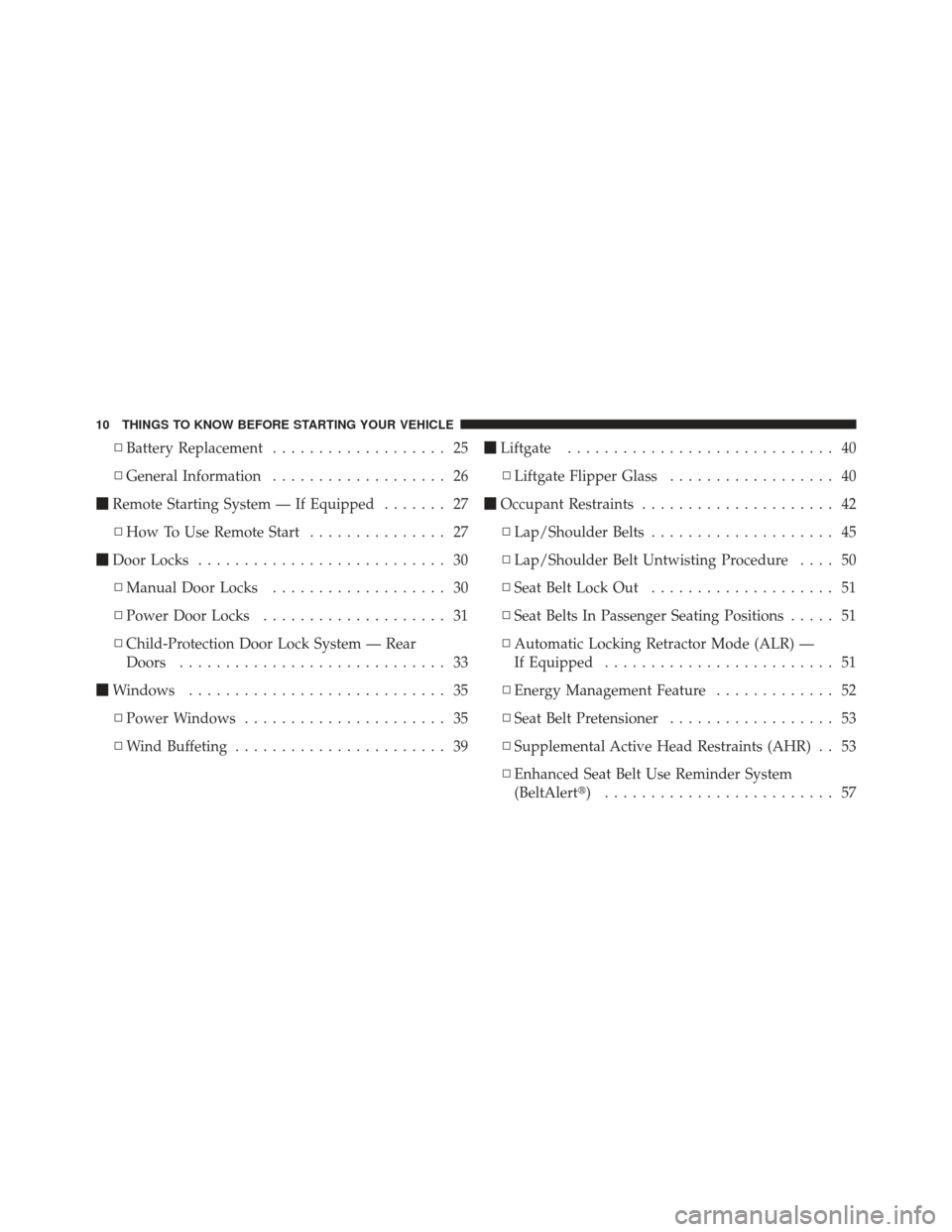
▫Battery Replacement ................... 25
▫ General Information ................... 26
� Remote Starting System — If Equipped ....... 27
▫ How To Use Remote Start ............... 27
� Door Locks ........................... 30
▫ Manual Door Locks ................... 30
▫ Power Door Locks .................... 31
▫ Child-Protection Door Lock System — Rear
Doors ............................. 33
� Windows ............................ 35
▫ Power Windows ...................... 35
▫ Wind Buffeting ....................... 39 �
Liftgate ............................. 40
▫ Liftgate Flipper Glass .................. 40
� Occupant Restraints ..................... 42
▫ Lap/Shoulder Belts .................... 45
▫ Lap/Shoulder Belt Untwisting Procedure .... 50
▫ Seat Belt Lock Out .................... 51
▫ Seat Belts In Passenger Seating Positions ..... 51
▫ Automatic Locking Retractor Mode (ALR) —
If Equipped ......................... 51
▫ Energy Management Feature ............. 52
▫ Seat Belt Pretensioner .................. 53
▫ Supplemental Active Head Restraints (AHR) . . 53
▫ Enhanced Seat Belt Use Reminder System
(BeltAlert�) ......................... 57
10 THINGS TO KNOW BEFORE STARTING YOUR VEHICLE
Page 27 of 558
During the PANIC Mode, the door locks and Remote
Keyless Entry (RKE) system will function normally.
PANIC mode will not disarm the Security System on
vehicles so equipped.
NOTE:You may need to be close to the vehicle when
using the RKE transmitter to turn off the PANIC Alarm
due to the radio frequency noises emitted by the system.
Programming Additional Transmitters
Refer to Sentry Key� “Customer Key Programming.”
If you do not have a programmed RKE transmitter,
contact your authorized dealer for details.
Battery Replacement
The recommended replacement battery is CR2032.
NOTE:
•Perchlorate Material — special handling may apply.
See www.dtsc.ca.gov/hazardouswaste/perchlorate
•Do not touch the battery terminals that are on the back
housing or the printed circuit board.
1. Remove the screw from the RKE transmitter case (if
equipped).
2
THINGS TO KNOW BEFORE STARTING YOUR VEHICLE 25
Page 28 of 558
2. With the RKE transmitter buttons facing down, use a
flat blade tool to pry the two halves of the RKE transmit-
ter case apart. Make sure not to damage the seal during
removal.3. Remove and replace the battery. Avoid touching the
new battery with your fingers. Skin oils may cause
battery deterioration. If you touch a battery, clean it with
rubbing alcohol.
4. To reassemble the RKE transmitter case, snap the two
halves together.
5. Reinstall and tighten the screw until snug (if
equipped).
General Information
This device complies with Part 15 of FCC rules and with
RS-210 of Industry Canada. Operation is subject to the
following conditions:
1. This device may not cause harmful interference.
2. This device must accept any interference that may be
received including interference that may cause undesired
operation.
Separating Case Halves
26 THINGS TO KNOW BEFORE STARTING YOUR VEHICLE
Page 29 of 558

NOTE:Changes or modifications not expressly ap-
proved by the party responsible for compliance could
void the user’s authority to operate the equipment.
If your RKE transmitter fails to operate from a normal
distance, check for these two conditions:
1. Weak battery in RKE transmitter. The expected life of
the battery is from one to two years.
2. Closeness to a radio transmitter such as a radio station
tower, airport transmitter, and some mobile or CB radios.
REMOTE STARTING SYSTEM — IF EQUIPPED
This system uses the Remote Keyless Entry
(RKE) transmitter to start the engine conve-
niently from outside the vehicle while still
maintaining security. The system has a range of
approximately 300 ft (91 m). NOTE:
•The vehicle must be equipped with an automatic
transmission to be equipped with Remote Start.
•Obstructions between the vehicle and RKE transmitter
may reduce this range.
How To Use Remote Start
All of the following conditions must be met before the
engine will remote start:
•Shift lever in PARK.
•Doors closed.
•Hood closed.
•Liftgate closed.
•Hazard switch off.
•Brake switch inactive (brake pedal not pressed).
•Ignition key removed from ignition switch.
2
THINGS TO KNOW BEFORE STARTING YOUR VEHICLE 27
Page 30 of 558
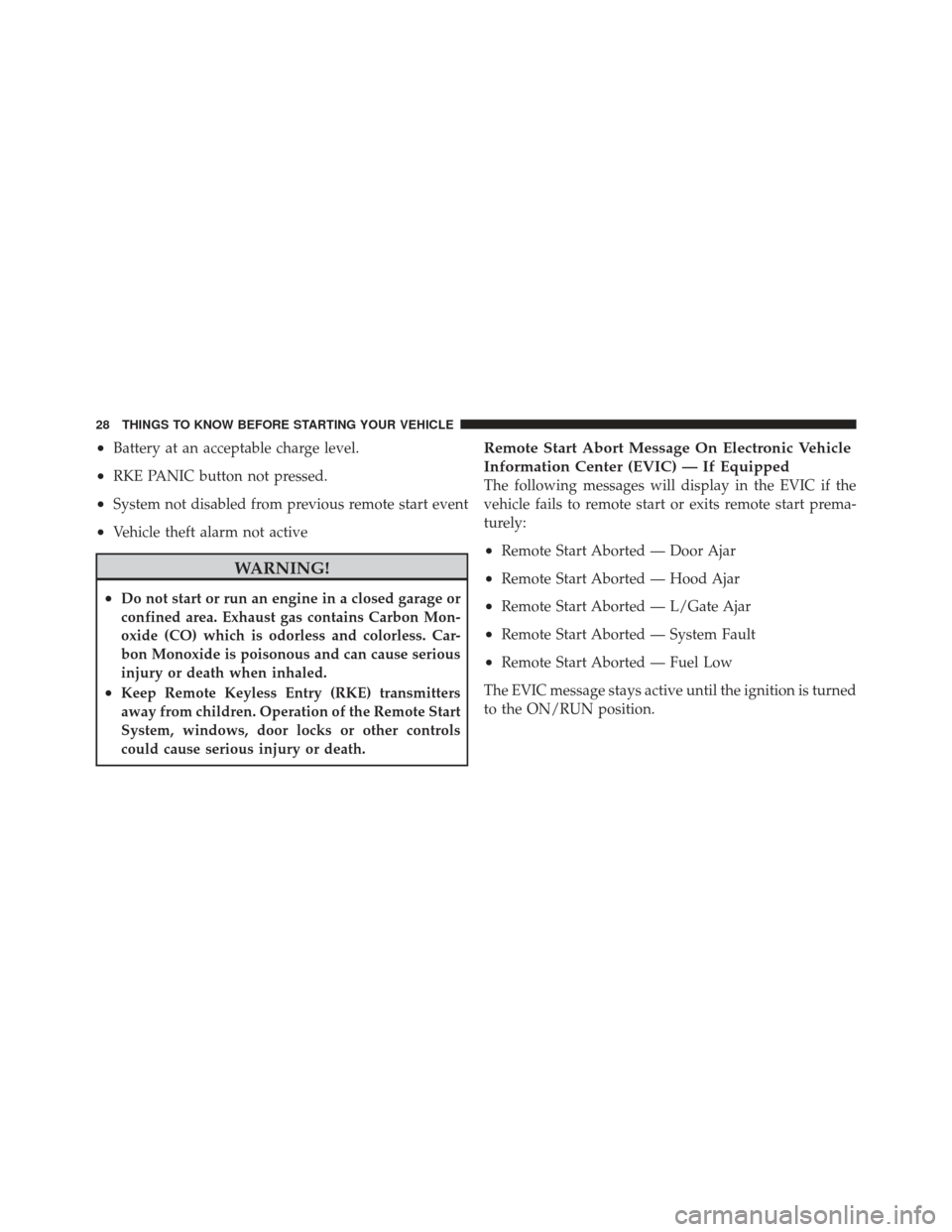
•Battery at an acceptable charge level.
•RKE PANIC button not pressed.
•System not disabled from previous remote start event
•Vehicle theft alarm not active
WARNING!
•Do not start or run an engine in a closed garage or
confined area. Exhaust gas contains Carbon Mon-
oxide (CO) which is odorless and colorless. Car-
bon Monoxide is poisonous and can cause serious
injury or death when inhaled.
•Keep Remote Keyless Entry (RKE) transmitters
away from children. Operation of the Remote Start
System, windows, door locks or other controls
could cause serious injury or death.
Remote Start Abort Message On Electronic Vehicle
Information Center (EVIC) — If Equipped
The following messages will display in the EVIC if the
vehicle fails to remote start or exits remote start prema-
turely:
•Remote Start Aborted — Door Ajar
•Remote Start Aborted — Hood Ajar
•Remote Start Aborted — L/Gate Ajar
•Remote Start Aborted — System Fault
•Remote Start Aborted — Fuel Low
The EVIC message stays active until the ignition is turned
to the ON/RUN position.
28 THINGS TO KNOW BEFORE STARTING YOUR VEHICLE
Page 68 of 558
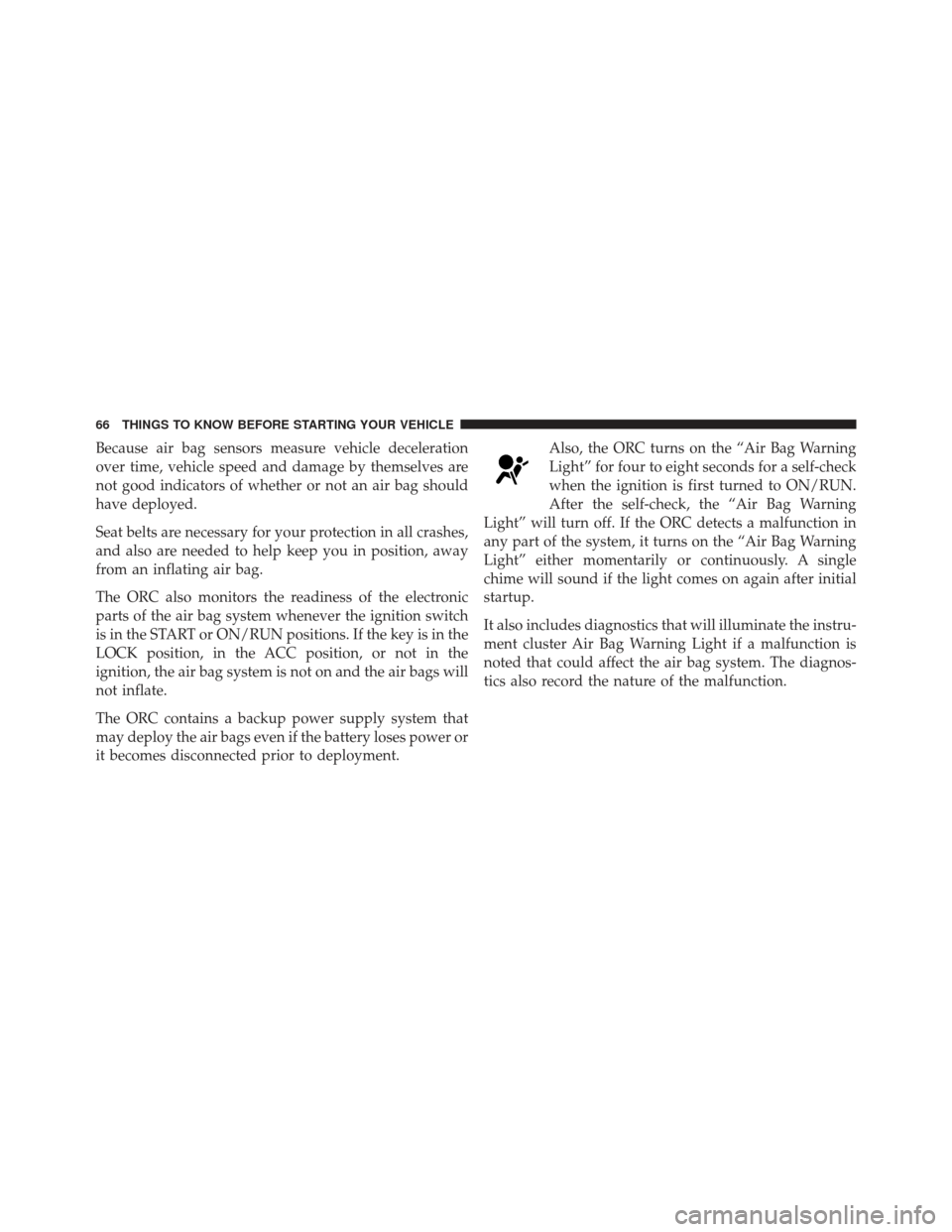
Because air bag sensors measure vehicle deceleration
over time, vehicle speed and damage by themselves are
not good indicators of whether or not an air bag should
have deployed.
Seat belts are necessary for your protection in all crashes,
and also are needed to help keep you in position, away
from an inflating air bag.
The ORC also monitors the readiness of the electronic
parts of the air bag system whenever the ignition switch
is in the START or ON/RUN positions. If the key is in the
LOCK position, in the ACC position, or not in the
ignition, the air bag system is not on and the air bags will
not inflate.
The ORC contains a backup power supply system that
may deploy the air bags even if the battery loses power or
it becomes disconnected prior to deployment.Also, the ORC turns on the “Air Bag Warning
Light” for four to eight seconds for a self-check
when the ignition is first turned to ON/RUN.
After the self-check, the “Air Bag Warning
Light” will turn off. If the ORC detects a malfunction in
any part of the system, it turns on the “Air Bag Warning
Light” either momentarily or continuously. A single
chime will sound if the light comes on again after initial
startup.
It also includes diagnostics that will illuminate the instru-
ment cluster Air Bag Warning Light if a malfunction is
noted that could affect the air bag system. The diagnos-
tics also record the nature of the malfunction.
66 THINGS TO KNOW BEFORE STARTING YOUR VEHICLE
Page 75 of 558
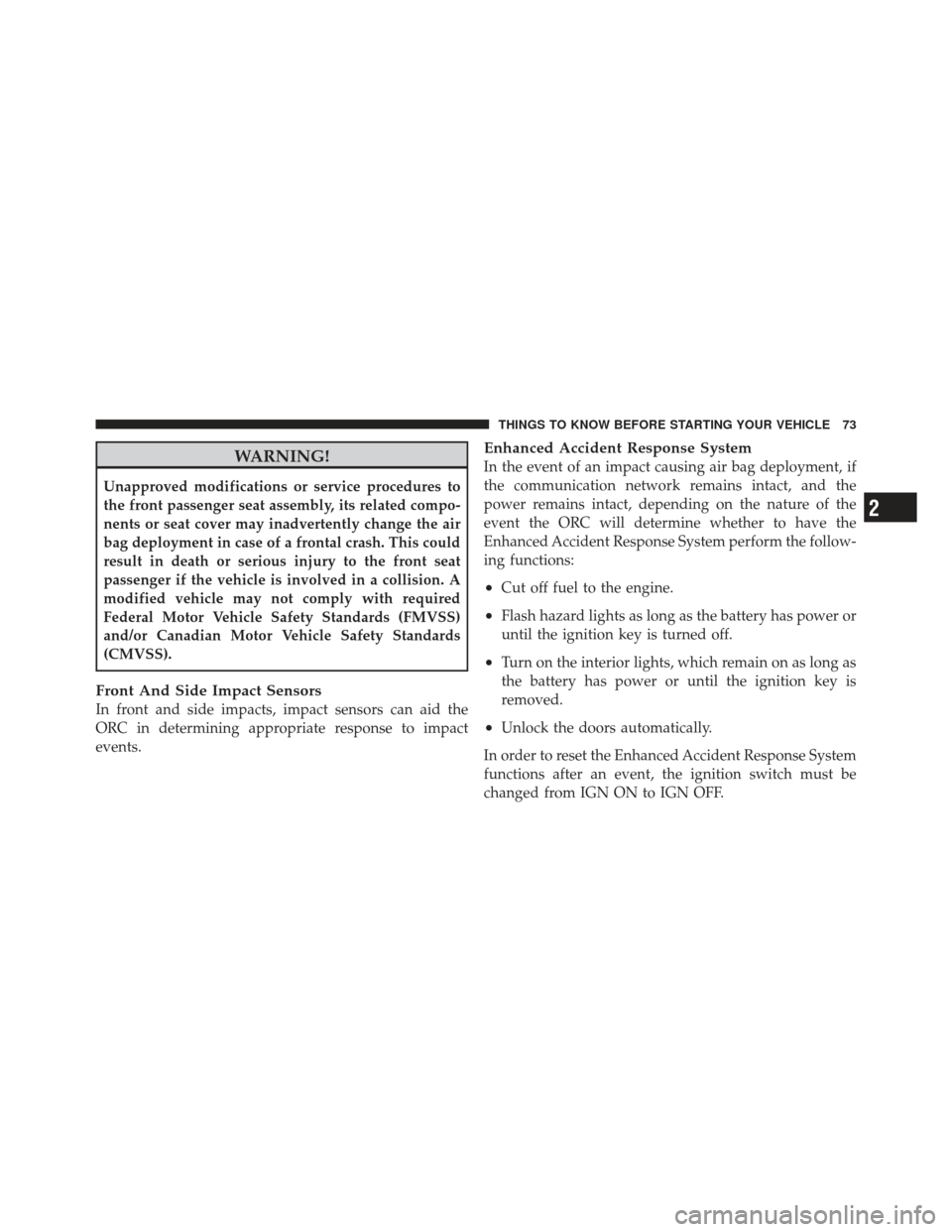
WARNING!
Unapproved modifications or service procedures to
the front passenger seat assembly, its related compo-
nents or seat cover may inadvertently change the air
bag deployment in case of a frontal crash. This could
result in death or serious injury to the front seat
passenger if the vehicle is involved in a collision. A
modified vehicle may not comply with required
Federal Motor Vehicle Safety Standards (FMVSS)
and/or Canadian Motor Vehicle Safety Standards
(CMVSS).
Front And Side Impact Sensors
In front and side impacts, impact sensors can aid the
ORC in determining appropriate response to impact
events.
Enhanced Accident Response System
In the event of an impact causing air bag deployment, if
the communication network remains intact, and the
power remains intact, depending on the nature of the
event the ORC will determine whether to have the
Enhanced Accident Response System perform the follow-
ing functions:
•Cut off fuel to the engine.
•Flash hazard lights as long as the battery has power or
until the ignition key is turned off.
•Turn on the interior lights, which remain on as long as
the battery has power or until the ignition key is
removed.
•Unlock the doors automatically.
In order to reset the Enhanced Accident Response System
functions after an event, the ignition switch must be
changed from IGN ON to IGN OFF.
2
THINGS TO KNOW BEFORE STARTING YOUR VEHICLE 73
Page 97 of 558
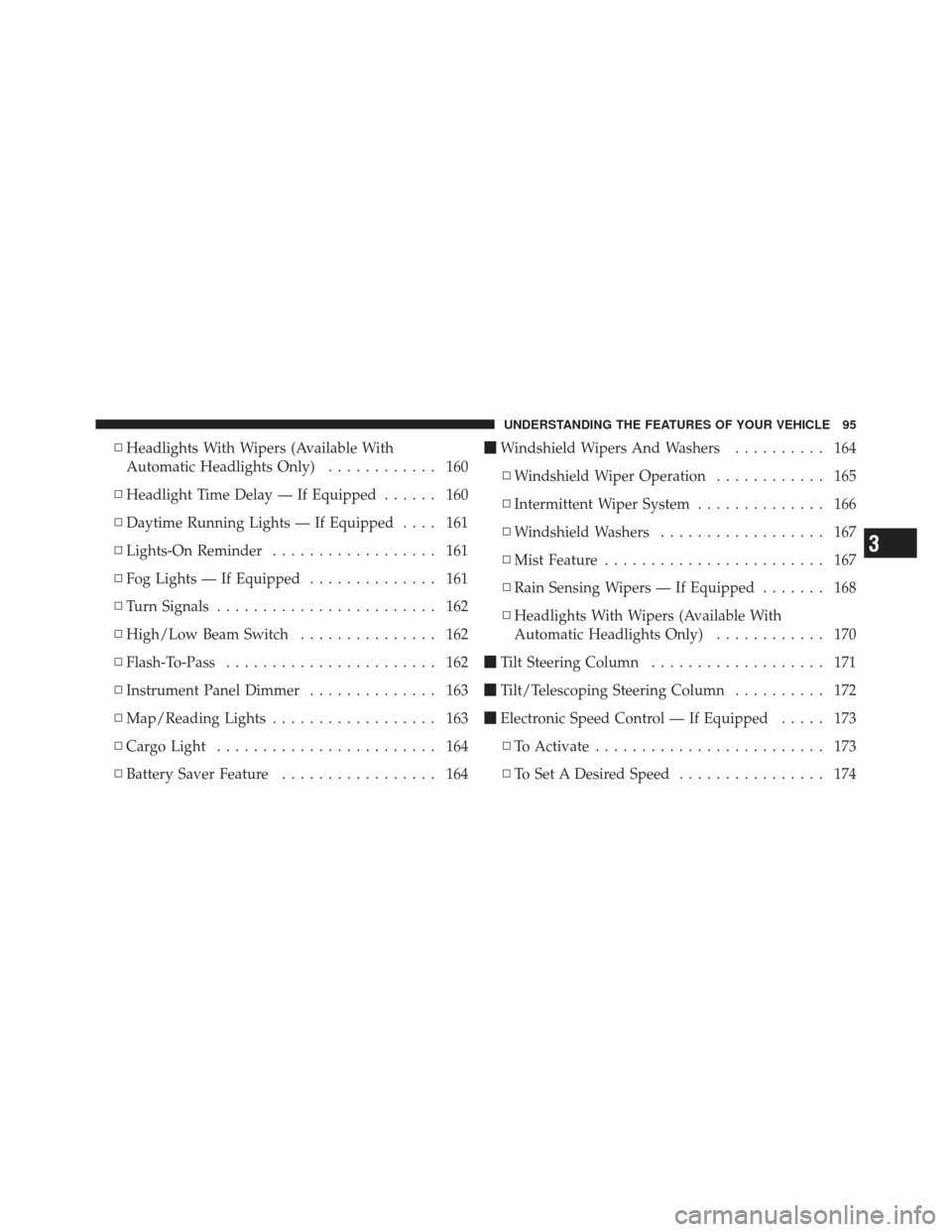
▫Headlights With Wipers (Available With
Automatic Headlights Only) ............ 160
▫ Headlight Time Delay — If Equipped ...... 160
▫ Daytime Running Lights — If Equipped .... 161
▫ Lights-On Reminder .................. 161
▫ Fog Lights — If Equipped .............. 161
▫ Turn Signals ........................ 162
▫ High/Low Beam Switch ............... 162
▫ Flash-To-Pass ....................... 162
▫ Instrument Panel Dimmer .............. 163
▫ Map/Reading Lights .................. 163
▫ Cargo Light ........................ 164
▫ Battery Saver Feature ................. 164 �
Windshield Wipers And Washers .......... 164
▫ Windshield Wiper Operation ............ 165
▫ Intermittent Wiper System .............. 166
▫ Windshield Washers .................. 167
▫ Mist Feature ........................ 167
▫ Rain Sensing Wipers — If Equipped ....... 168
▫ Headlights With Wipers (Available With
Automatic Headlights Only) ............ 170
� Tilt Steering Column ................... 171
� Tilt/Telescoping Steering Column .......... 172
� Electronic Speed Control — If Equipped ..... 173
▫ To Activate ......................... 173
▫ To Set A Desired Speed ................ 174
3
UNDERSTANDING THE FEATURES OF YOUR VEHICLE 95